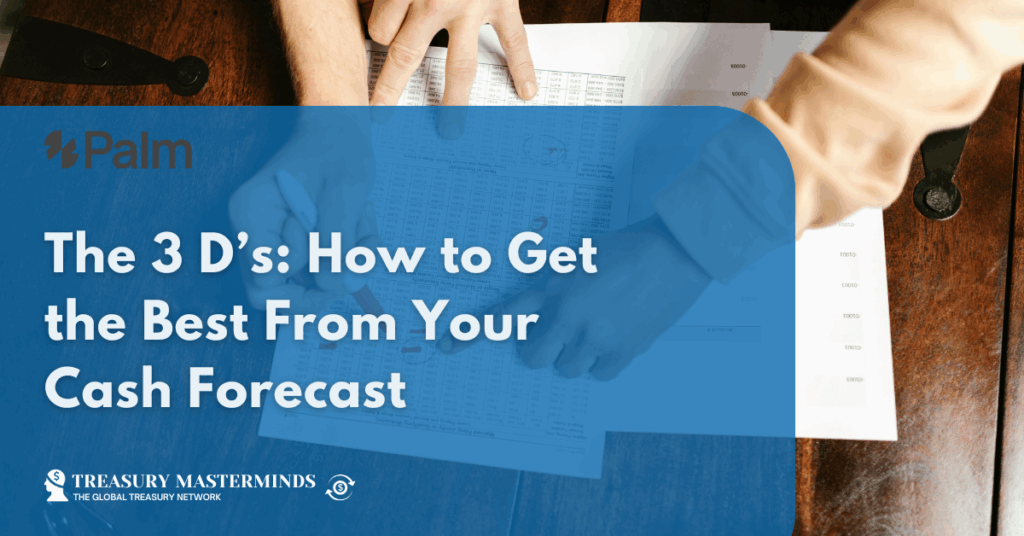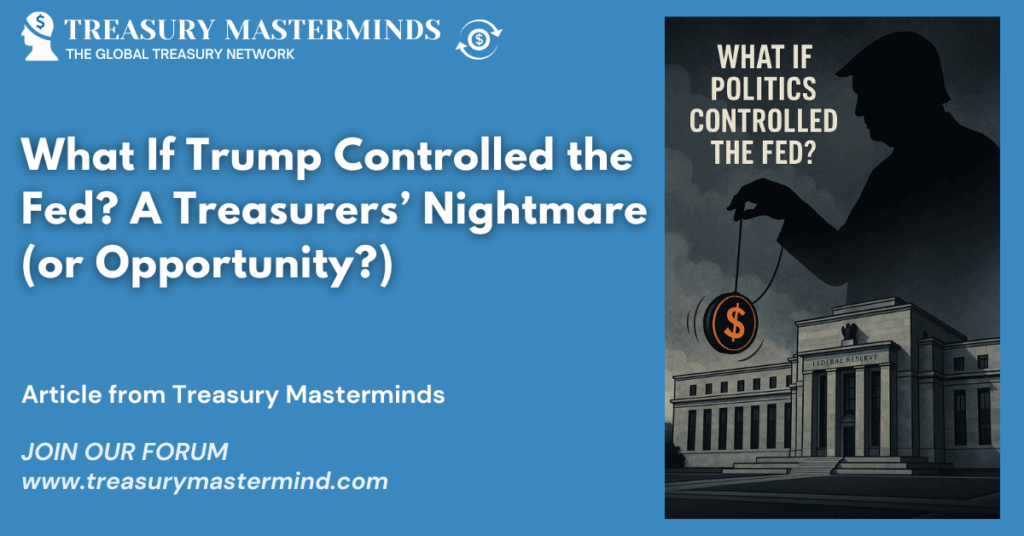
The 3 D’s: How to Get the Best From Your Cash Forecast
This article is written by Palm We talk so much about cash forecasting and it’s importance, however how we approach this critical task has barely changed in the last 10 years. We may have added more data and reference points to help the analysis, but fundamentally we are looking at what has happened, adding in some general ledger data, the FP&A forecast and hoping for the best. The treasurer may go a step further and add their own view of the business progression to give an extra flavour. But the real science behind the numbers is rarely understood or utilised. …And we wonder why we some months we are so accurate, and others we are so wildly inaccurate it’s comical. In this blog we explore how to approach the task of cash forecasting differently. How to use the latest technology to break through into the new era of looking-ahead. The Opportunity: Where we can add real value by using the latest tools? 1. Data The data we use in our forecasts doesn’t have to be purely financial data relating to your internal operations. Think outside of the box about other external factors that effect the success of the business. Is it the weather forecast, the performance of the economy or the marketing of competitor products? Whatever it is, you can use this data to improve the quality of your cash flow forecast. 2. Details Imagine you had unlimited time to analyse every piece of data you feed into your forecast, for example, you could build in logic to understand the payment behaviour of each of your customers knowing some always pay between 3-5 days late depending one which day the invoice falls due and when their weekly payment run is. Or, a model that understands that before year end, some invoices due for payment are brought forward to limit open balance sheet positions. However, instead of spending hours analysing and creating this logic, the model understands these trends and does it for you. 3. Direction Unlike your best Treasury Analyst, your machine learning forecast model will never leave you. Therefore spending time teaching it all that you know, speaking to it directly to explain why somethings are correct and others aren’t, is a time investment that will pay off in dividends over the years. You can tell your forecast, for example, that it has misunderstood the seasonality of your business due to strange one-off behaviour and to exclude this from the its trend analysis in future. Giving this feedback regularly will also help the model learn more about the business and the trends it detects. The Technology: What do we need to achieve this? Although not new, it is surprising how few treasuries are using AI and machine learning in their day to day operations. According to the 2024 Deloitte survey, it is less than 2%. Is this because the technology is not properly understood? Or it’s application hasn’t been facilitated in a way that is accessible to treasurers? My suspicion is that it is a mix of both. What are the technologies you can use to realise the benefits we’ve outlined in the above sections? Predictive AI Using different data sets, AI can predict what will happen with the future of your cash flows. The difference between this technology and your treasury team itself, is that you can supply many different and varying data sets in different formats to feed the model. This will have a limited impact on the amount of time the forecast takes to produce however will significantly improve the accuracy. The difference between predictive AI and generative AI is that predictive AI uses existing data sets to predict what will happen in the future and is therefore most relevant for producing you cash flow forecast. Generative AI however creates new and original content, such as the commentary to support the forecast and understand the cash flows. Machine Learning Mathematical models are the foundation of machine learning, often using several at once and testing each of them until you find a blend that works. These can be refined over time to achieve the optimal solution. The Reality- What will happen when you bring these technologies into your treasury? When applying these systems and models you will be required a change your expectations of your forecast model. The advantage of using mathematical statistical models to produce your cash forecast means it will predict your cash flow for you, however you must relinquish your power to the model. You need to accept that you will not be able to click into a cell in excel and see how a number is calculated. You will not be able to “follow it through”. As many of the trends of patterns it detects are not necessarily explainable. Of course you can adjust the forecast and amend it to include the additional information you have, you could also feed it with a set of assumptions you believe to be true as guidance for the model to follow, for example, headcount is set to grow by 2% each month from now until the end of 2025 however on the most part you will not be able to see its inner workings. To become comfortable with this will take time and adjustment, building trust in the model over time and conducting regular variance analysis to pinpoint the route cause of any differences will help both you and the model. However, it is in embracing these innovations and new ways of looking at data that we can truly unlock our cash and bring efficiencies into our treasury teams. Also Read Join our Treasury Community Treasury Masterminds is a community of professionals working in treasury management or those interested in learning more about various topics related to treasury management, including cash management, foreign exchange management, and payments. To register and connect with Treasury professionals, click [HERE] or fill out the form below. Notice: JavaScript is required for this content.

What If Trump Controlled the Fed? A Treasurers’ Nightmare (or Opportunity?)
From Treasury Masterminds Donald Trump has never been shy about saying the quiet part out loud. And one of his long-standing frustrations is the Federal Reserve. He wants more influence; he wants “his” Fed. But what if that actually happened? What if Trump, or any political leader, had full influence over the Fed? For treasurers, this is more than a political curiosity. It could mean a world where monetary policy shifts not on fundamentals, but on tweets, moods, or election cycles. Let’s fantasise for a moment what that world would look like. 1. Interest Rates on a Yo-Yo In a Trump-controlled Fed, interest rate decisions might become politically motivated: For treasurers, this means your hedging strategy becomes a guessing game. Forget stable forward guidance – instead, you’d live in a world of uncertainty, where risk managers become amateur political analysts. UPCOMING PODCAST Join us for “From Treasurer to TMS Trailblazer” with Quique Fernandez of Embat and discover how treasury leaders can shape the future of tech. Click below to register now and attend! 2. The Dollar as a Weapon Trump already loves to talk about “currency manipulation.” With full Fed influence, we could see direct interventions in FX markets to push the dollar up or down, depending on what fits the political script. For multinational treasurers: 3. Inflation Targeting? What Inflation Targeting? Central banks like to remind us that their mandate is “price stability.” But under political control, inflation could become a secondary concern. Imagine rates kept too low for too long, stoking inflation, simply because “growth looks good on TV.” For treasurers, this means: 4. The End of Central Bank Independence For decades, central bank independence has been a stabilising anchor. Lose that, and you lose credibility in the markets. If the Fed is seen as a political toy, we might see: That flows straight into corporate financing costs. Your next bond issue? It might come with a “Trump risk premium.” 5. Opportunity Amid the Chaos? It’s not all doom and gloom. Treasurers thrive in volatility (at least the good ones do). A Trump-influenced Fed could: The winners would be the treasurers who stop waiting for “certainty” and instead build resilience into their structures. Our 2 Cents Trump having full control of the Fed may sound like a fantasy—or a nightmare—but it raises a serious point:Treasurers cannot take central bank independence for granted anymore. Whether it’s Trump, another populist, or just political pressure creeping into monetary policy, we may be entering a new era where policy is less predictable, more volatile, and more political. And that means treasury teams need to adapt. Build flexibility, invest in systems, and prepare for the day when rate decisions are made in the Oval Office, not the Fed boardroom. Because if that day comes, you’ll want to be ready. Also Read Join our Treasury Community Treasury Mastermind is a community of professionals working in treasury management or those interested in learning more about various topics related to treasury management, including cash management, foreign exchange management, and payments. To register and connect with Treasury professionals, click [HERE] or fill out the form below to get more information. Notice: JavaScript is required for this content.